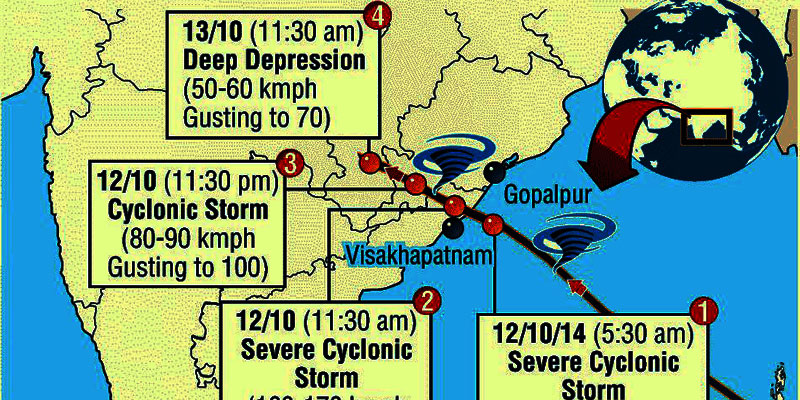Cyclone Hudhud in India, It was this accuracy that thousands of lives were saved from the wrath of the cyclone.
The Indian Meteorological Department catches the bull by its horns when it comes to predicting accurate time, velocity and place of the cyclonic landfalls. As it did last year with destructive Phailin, this year too, IMD accurately put the place of the landfall (Vishakhapatnam), timing (shortly before noon) and the velocity of wind (170-180 km/hr, gusting up to 195 km/hr) accompanying cyclone Hudhud.
It was this accuracy that thousands of lives were saved from the wrath of the cyclone.
The India Express reported, before Hudhud made landfall, over 67,000 people were evacuated from the vulnerable areas of south Orissa and coastal Orissa and moved to safe shelters. In Ganjam alone, over 26,000 people were moved to safe shelters.
IMD officials in Bhubaneswar expect rainfall up to 250 mm in Malkangiri, Koraput, Rayagada, Nawarangpur, Ganjam, Gajpati, Kalahandi, Nayagarh, Khurda, Puri, Nawapara, Boudh, Bolangir, Sonepur and Phulbani districts in the next 24 hours.
The intensity of rainfall is expected to subside October 15 onwards.
However, in Andhra Pradesh, there was a massive trail of destruction. Thankfully, people were saved from the areas of the landfall by hundreds of police and NDRF personnel who rescued people stuck in vehicles on highways, especially NH 9, through which officials claim the eye of the storm passed.
The IE presented the picture of destruction: Signboards, hoardings, sheets of metal and glass lay all over the road. Window panes of buildings, galass facades of malls and showrooms, windshields of vehicles all shattered under the force of the wind in Visakhapatnam, a city of steel and port, spreading panic.
The rain that followed inundated lakhs of acres of cultivated land, with damage expected to paddy, banana and other crops. Low-lying areas up to 50 km inside were flooded.
The accurate prediction also left the government and Navy with enough time to strategise. The Navy launched Operation Leher and Armed forces along with Coast Guards are helping in this operation.
Reportedly, the Andhra Sub-Area of Army has already deployed four teams of its personnel at Visakhapatnam and four teams at Srikakulam (Tekkali and Echerla). Around 300 life jackets and 12 boats have been provided to them.
A Disaster Management Cell at Air Defence College, Gopalpur has been established.
IE said that the Army has also kept 25 rescue teams and two engineer task forces on standby at Ranchi, Allahabad and Secunderabad.
The report elaborated that the Navy has has kept 30 diving teams with Gemini craft and associated equipment, 20 rescue teams, four ships with medical bricks and medical stores, two medical teams, six helicopters and two planes and two medical teams ready at Visakhapatnam. To bolster the transport efforts, IAF has kept one IL-76, one C-17 and five AN-32 aircraft ready at Chandigarh, Delhi, Jorhat and Agra.
The Indian Coast Guard has also deployed 17 ships, two air cushion vessels and 13 aircrafts.
The penetration of media in the rural areas has certainly helped governments spread the message, but without accurate forcast it would not have worked that well. The IMD, time and again, has proved its mettle by accurately predicting weather phenomena.





